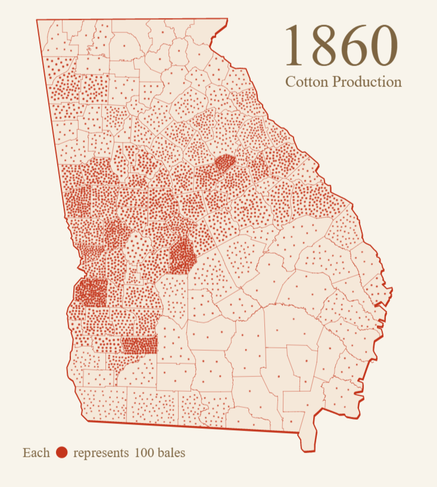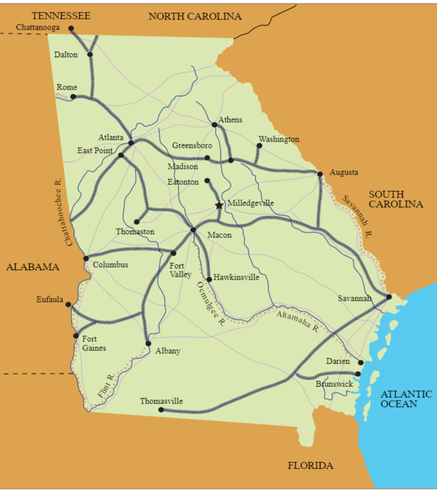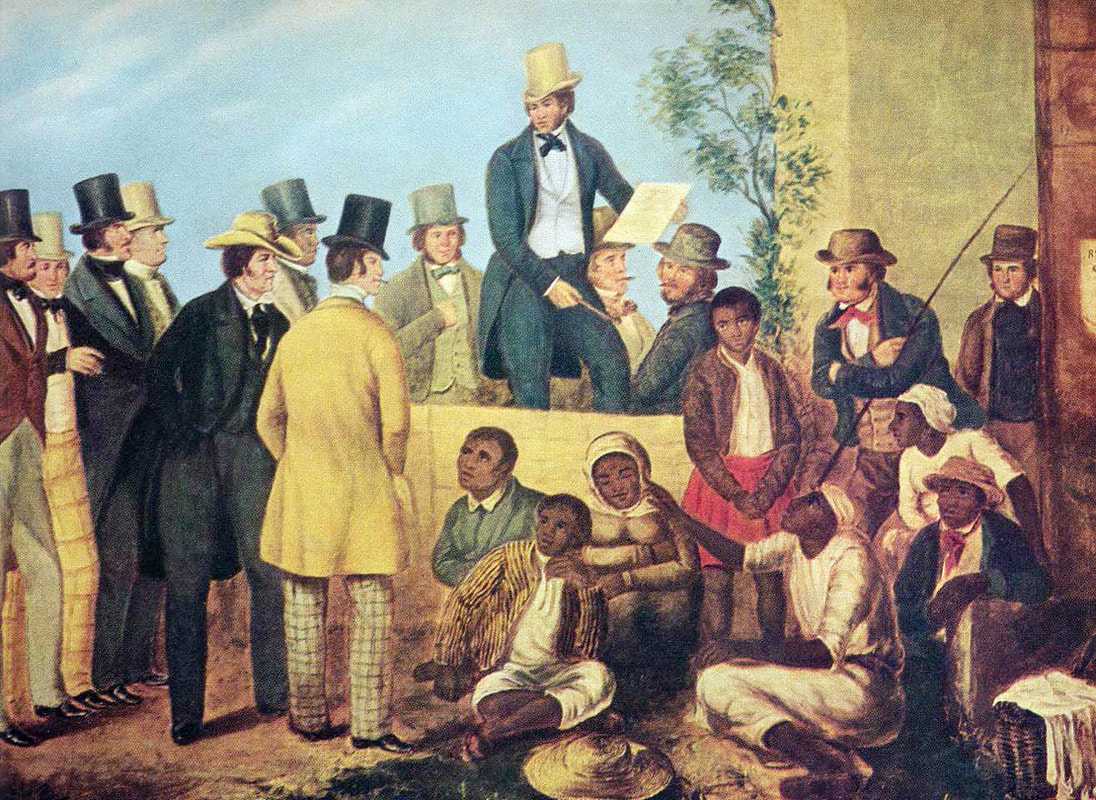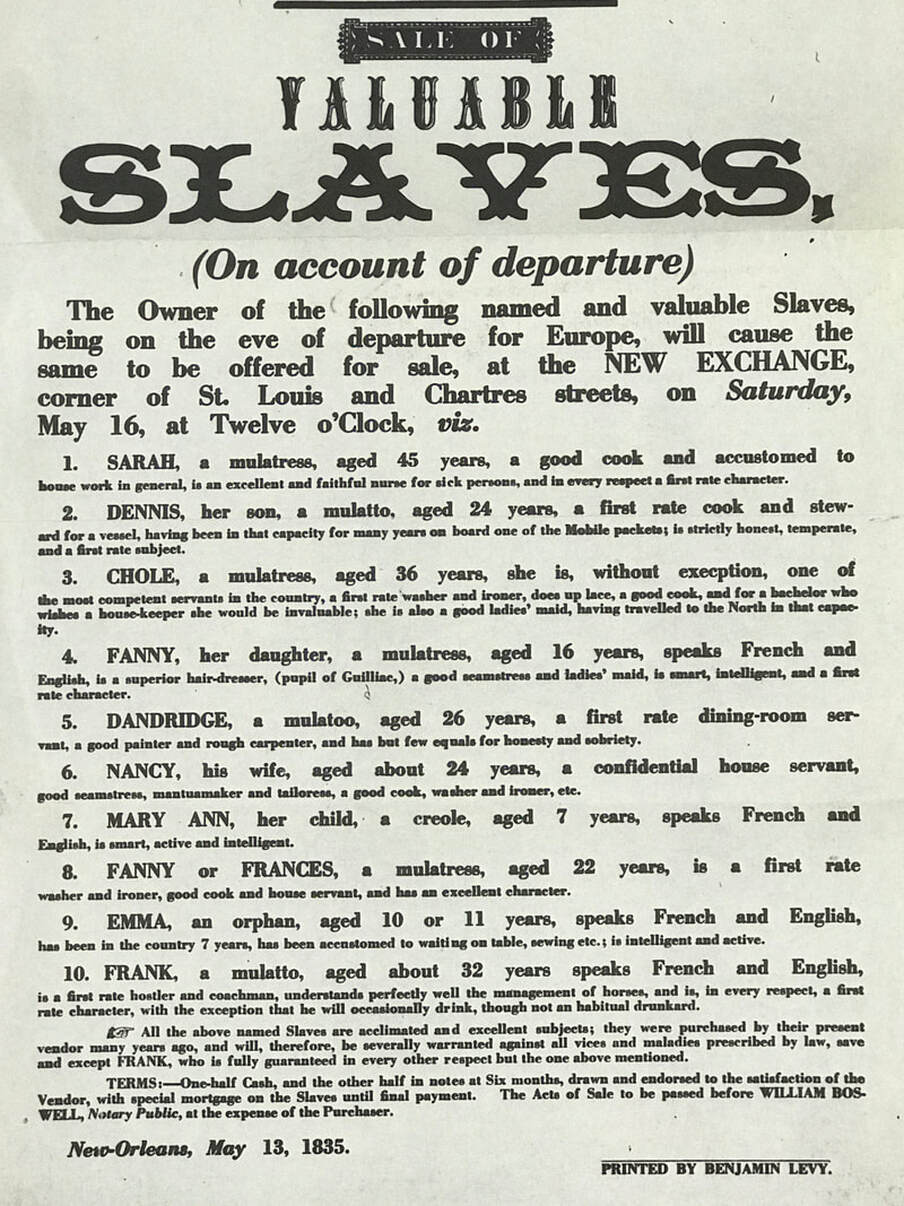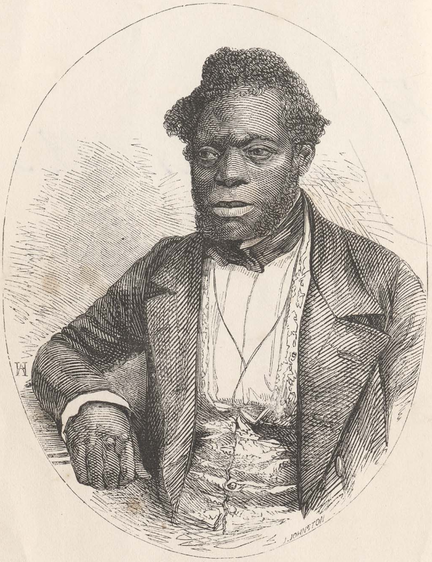Unit 7- Antebellum Georgia
SS8H4- Explain significant factors that affected westward expansion in Georgia between 1789 and 1840.
C. Explain how technological developments, including the cotton gin and railroads, had an impact on Georgia’s growth.
SS8H5- Analyze the impact of the Civil War on Georgia.
A. Explain the importance of key issues and events that led to the Civil War; include slavery, states’ rights, nullification, Compromise of 1850 and the Georgia Platform, the Dred Scott case, Abraham Lincoln’s election in 1860, and the debate over secession in Georgia
C. Explain how technological developments, including the cotton gin and railroads, had an impact on Georgia’s growth.
SS8H5- Analyze the impact of the Civil War on Georgia.
A. Explain the importance of key issues and events that led to the Civil War; include slavery, states’ rights, nullification, Compromise of 1850 and the Georgia Platform, the Dred Scott case, Abraham Lincoln’s election in 1860, and the debate over secession in Georgia
The antebellum period was a time for prosperity in Georgia. In 1790, it was one of the poorest states in the nation. By the 1850s, Georgia was doing so well that it was hailed as the “Empire State of the South.”
What caused this change? The two factors most responsible for Georgia’s growth were cotton and slavery. But there were other reasons for the state’s progress. Georgia’s government had encouraged a massive railroad-building program throughout the state, giving it one of the best systems in the Deep South.
Other industries were growing too, such as textile mills, lumber yards, leather goods factories, metal works, and stone quarries.
What caused this change? The two factors most responsible for Georgia’s growth were cotton and slavery. But there were other reasons for the state’s progress. Georgia’s government had encouraged a massive railroad-building program throughout the state, giving it one of the best systems in the Deep South.
Other industries were growing too, such as textile mills, lumber yards, leather goods factories, metal works, and stone quarries.
Slavery in Georgia: Eli Whitney- The Man and His Invention
Cotton became an important crop in Georgia in the late 1700s. In 1786, sea island cotton from the Bahama Islands was introduced in Georgia. Sea island cotton—so named because it grew only on sea islands and along the coast—had long fibers and could be woven into soft, high-quality cloth.
Another type of cotton, a short-fiber variety, was a hardy plant that could be grown far inland. This short-fiber variety produced more cotton per acre than sea island cotton. But short-fiber cotton had a major drawback. Its seeds were so tightly entangled with the cotton fiber that it was a very slow process to remove
the seeds by hand (if working steady for eight hours, one pound of "clean" cotton could be produced by hand). The invention of the cotton gin in 1793 speeded up the process dramatically. Soon, cotton was “king” of the crops in Georgia.
Another type of cotton, a short-fiber variety, was a hardy plant that could be grown far inland. This short-fiber variety produced more cotton per acre than sea island cotton. But short-fiber cotton had a major drawback. Its seeds were so tightly entangled with the cotton fiber that it was a very slow process to remove
the seeds by hand (if working steady for eight hours, one pound of "clean" cotton could be produced by hand). The invention of the cotton gin in 1793 speeded up the process dramatically. Soon, cotton was “king” of the crops in Georgia.

The gin separated the sticky seeds from the fibers in short-staple cotton, which was easy to grow in the Deep South but difficult to process. The gin improved the separation of the seeds and fibers by a factor of 50, but the cotton still needed to be picked by hand. The demand for cotton roughly doubled each decade following Whitney’s invention. So cotton became a very profitable crop that also demanded a growing slave-labor force to harvest it.
Slavery in Georgia: Where and Why?
Eli Whitney’s remarkable cotton gin made it possible to grow and process cotton farn into the state’s interior. All that was needed was well-drained topsoil, a growing season of about 200 days without frost, 25 to 45 inches of rainfall each year, and a dry harvest season. These conditions were found in much of Georgia’s Piedmont and Coastal Plain. A most suitable combination of soil and climate was present near the Fall Line.
Georgia’s Fall Line region attracted cotton planters for another reason. The geography of this area created favorable conditions for industry. As rivers flowed southward through this zone, the water picked up speed. The moving water could then be used to power cotton gins, textile mills, and factories.
The arrival of steamboats in the 1820s provided Georgia planters a better way to transport large quantities of cotton to the ocean port at Savannah. By the 1840s, railroad construction gave planters another option. They no longer had to depend on river transportation. Using the rail lines, they could extend the cotton region far north of the Fall Line into Georgia’s Piedmont.
The success of Whitney’s cotton gin lured many people into growing the white fiber plant. But growing cotton was labor intensive, requiring many hours of work. Field hands were needed to plant, hoe, and pick the crop. And it was all done by hand— there were no machines. To make a profit, a planter needed a ready supply of cheap labor that would work long hours. Slavery filled that need, and cotton planters came to rely on it.
In 1790, only 1,000 bales were produced, mostly of the sea island variety. By 1840 production rose to over 400,000 bales of shortfiber cotton and by 1860 to over 700,000 bales.
Georgia’s Fall Line region attracted cotton planters for another reason. The geography of this area created favorable conditions for industry. As rivers flowed southward through this zone, the water picked up speed. The moving water could then be used to power cotton gins, textile mills, and factories.
The arrival of steamboats in the 1820s provided Georgia planters a better way to transport large quantities of cotton to the ocean port at Savannah. By the 1840s, railroad construction gave planters another option. They no longer had to depend on river transportation. Using the rail lines, they could extend the cotton region far north of the Fall Line into Georgia’s Piedmont.
The success of Whitney’s cotton gin lured many people into growing the white fiber plant. But growing cotton was labor intensive, requiring many hours of work. Field hands were needed to plant, hoe, and pick the crop. And it was all done by hand— there were no machines. To make a profit, a planter needed a ready supply of cheap labor that would work long hours. Slavery filled that need, and cotton planters came to rely on it.
In 1790, only 1,000 bales were produced, mostly of the sea island variety. By 1840 production rose to over 400,000 bales of shortfiber cotton and by 1860 to over 700,000 bales.
Slavery in Georgia: The Human Factor
Slavery in Georgia: The Political Factor
|
Upon his return to Missouri, Scott sued the state based on the belief that his time spent in the free states made him a free man. When the case made it to the Supreme Court, the court ruled on the side of Missouri. The Court went on to declare that slaves and freed blacks were not citizens of the United States and did not have the right to sue in the first place. |



